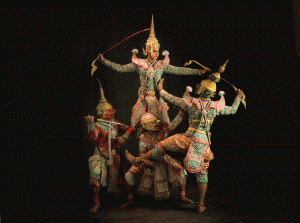Drama and Literature

Drama
In the purely classical form, Thai drama and dance are indivisible.
The Khon masked drama is derived from Indian temple rituals and dancing and draws its story line from the Ramakien, the Thai version of the Indian epic Ramayana. During the Ayutthaya period, the Khon was acted by accomplished male court retainers playing both male and female roles because until the 19th century the movements were thought too strenuous for women to perform. By the mid 1800s both men and women were appearing on stage together.
Performances of Khon are characterized by vigorous, highly-formalized action. Acting and dancing are inseparable, each step having a definite meaning which is emphasized by precisely defined music to suggest walking, marching laughing, etc. because some actors and actresses are masked and cannot speak, narrative verses are usually recited and sung by a chorus that sits with the accompanying woodwind, gong and drum ensemble. The leading male and female performers do not wear masks and on some occasions they may speak.
Literature
One of the most important Thai literary works is the Ramakien, a uniquely Thai version of the Indian epic Ramayana. Early Thai versions of the Ramakien were lost in the destruction of Ayutthaya. The longest of the three present versions was written in 1789 by the first Chakri King, Rama I, and a group of intimates who incorporated Thai and Buddhist elements into it to preserve oral knowledge of Ayutthaya state rites and traditions. Indeed, King Rama I’s Ramakien is the major historical source of medieval Thai courtly traditions.
Another major Thai literary figure was Sunthon Phu (1786-1855), a poetic genius and well-beloved commoner. Sunthon Phu’s enduring achievement was to write supremely well in common language about common feelings and common people. Easily understood by all classes, his work became widely accepted. His major works were Prha Aphai Mani, a romantic adventure, and nine Nirats mostly written during a pilgrimage, associating romantic memories with the places he visited in central and eastern Thailand.
In the modern age, from about 1900 onward, most Thai readers are acquainted with work of Dokmaisod, the pen name of M.L. Boopha Nimmanhaemindha. Among her pioneering novels were Phu Di, Nung Nai Roi, Nit, Chaichana Khong Luang, Naruban. Many of her works are assigned reading for students at the secondary and tertiary levels of education today.


